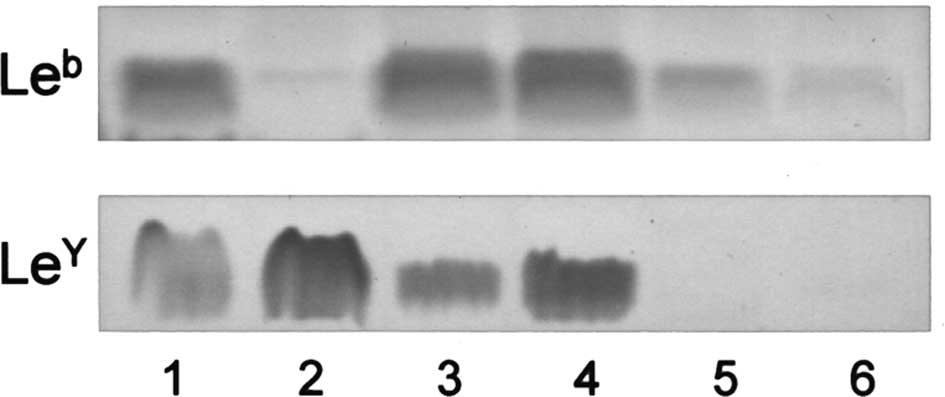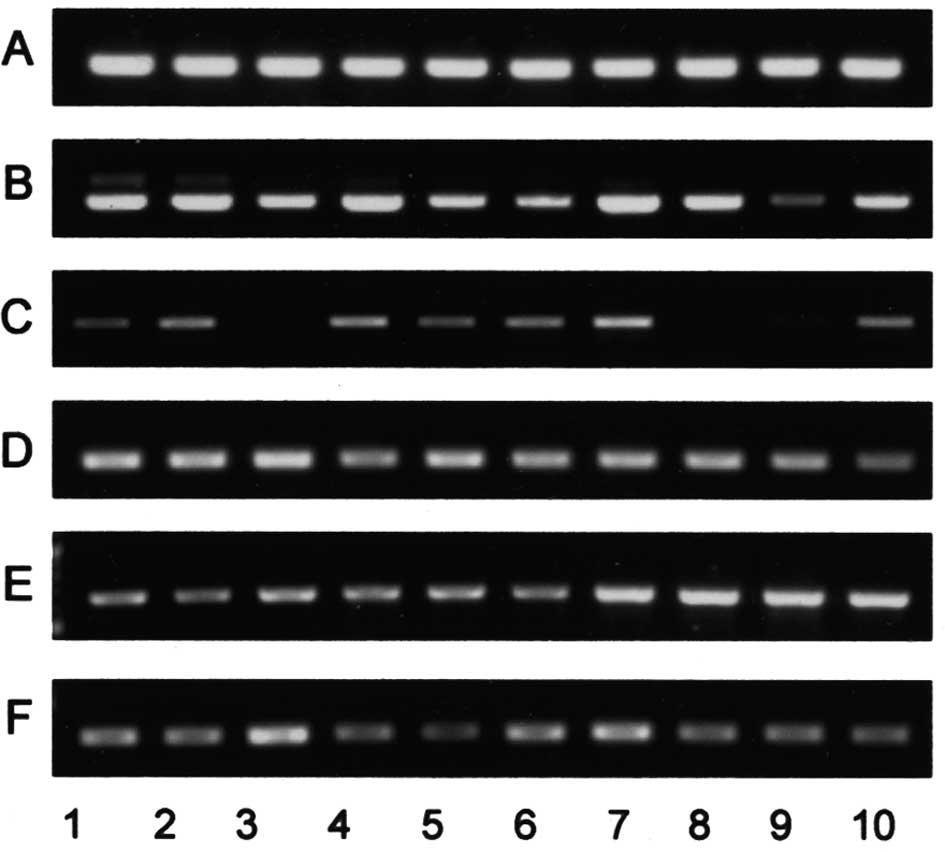|
1
|
Roseman S: Reflections on glycobiology. J
Biol Chem. 276:41527–41542. 2001. View Article : Google Scholar : PubMed/NCBI
|
|
2
|
Koprowski H, Herlyn M, Steplewski Z and
Sears HF: Specific antigen in serum of patients with colon
carcinoma. Science. 212:53–55. 1981. View Article : Google Scholar : PubMed/NCBI
|
|
3
|
Canney PA, Wilkinson PM, James RD and
Moore M: CA19-9 as a marker for ovarian cancer: alone and in
comparison with CA125. Br J Cancer. 52:131–133. 1985. View Article : Google Scholar : PubMed/NCBI
|
|
4
|
Sgroi D, Varki A, Braesch-Andersen S and
Stamenkovic I: CD22, a B cell-specific immunoglobulin superfamily
member, is a sialic acid-binding lectin. J Biol Chem.
268:7011–7018. 1993.PubMed/NCBI
|
|
5
|
Springer TA and Lasky LA: Cell adhesion.
Sticky sugars for selectins. Nature. 349:196–197. 1991. View Article : Google Scholar : PubMed/NCBI
|
|
6
|
Imai Y, Singer MS, Fennie C, Lasky LA and
Rosen SD: Identification of a carbohydrate-based endothelial ligand
for a lymphocyte homing receptor. J Cell Biol. 113:1213–1221. 1991.
View Article : Google Scholar : PubMed/NCBI
|
|
7
|
Kiguchi K, Takamatsu K, Tanaka J, Nozawa
S, Iwamori M and Nagai Y: Glycosphingolipids of various human
ovarian tumors: a significantly high expression of
I3SO3GalCer and Lewis antigen in mucinous
cystadenocarcinoma. Cancer Res. 52:416–421. 1992.PubMed/NCBI
|
|
8
|
Iwamori M, Tanaka K, Kubushiro K, Lin B,
Kiguchi K, Ishiwata I, Tsukazaki K and Nozawa S: Alterations in the
glycolipid composition and cellular properties of ovarian
carcinoma-derived RMG-1 cells on transfection of the
alpha1,2-fucosyltransferase gene. Cancer Sci. 96:26–30. 2005.
View Article : Google Scholar : PubMed/NCBI
|
|
9
|
Kiguchi K, Iwamori Y, Suzuki N, Kobayashi
Y, Ishizuka B, Ishiwata I, Kita T, Kikuchi Y and Iwamori M:
Characteristic expression of globotriaosyl ceramide in human
ovarian carcinoma-derived cells with anticancer drug resistance.
Cancer Sci. 97:1321–1326. 2006. View Article : Google Scholar : PubMed/NCBI
|
|
10
|
Iwamori M, Iwamori Y, Kubushiro K,
Ishiwata I and Kiguchi K: Characteristic expression of
Lewis-antigenic glycolipids in human ovarian carcinoma-derived
cells with anticancer drug-resistance. J Biochem. 141:309–317.
2007. View Article : Google Scholar : PubMed/NCBI
|
|
11
|
Goupille C, Marionneau S, Bureau V,
Hallouin F, Meichenin M, Rocher J and Le Pendu J:
alpha1,2-Fucosyltransferase increases resistance to apoptosis of
rat colon carcinoma cells. Glycobiology. 10:375–382. 2000.
View Article : Google Scholar : PubMed/NCBI
|
|
12
|
Baldus SE, Hanisch FG, Pütz C, Flucke U,
Mönig SP, Schneider PM, Thiele J, Hölscher AH and Dienes HP:
Immunoreactivity of Lewis blood group and mucin peptide core
antigens: correlations with grade of dysplasia and malignant
transformation in the colorectal adenoma-carcinoma sequence. Histol
Histopathol. 17:191–198. 2002.
|
|
13
|
Iwamori M, Takamizawa K, Momoeda M,
Iwamori Y and Taketani Y: Gangliosides in human, cow and goat milk,
and their abilities as to neutralization of cholera toxin and
botulinum type A neurotoxin. Glycoconj J. 25:675–683. 2008.
View Article : Google Scholar : PubMed/NCBI
|
|
14
|
Lin B, Kubushiro K, Akiba Y, Cui Y,
Tsukazaki K, Nozawa S and Iwamori M: Alteration of acidic lipids in
human sera during the course of pregnancy: characteristic increase
in the concentration of cholesterol sulfate. J Chromatogr B Biomed
Sci Appl. 704:99–104. 1997. View Article : Google Scholar : PubMed/NCBI
|
|
15
|
Tanaka K, Kubushiro K, Iwamori Y, Okairi
Y, Kiguchi K, Ishiwata I, Tsukazaki K, Nozawa S and Iwamori M:
Estrogen sulfotransferase and sulfatase: roles in the regulation of
estrogen activity in human uterine endometrial carcinomas. Cancer
Sci. 94:871–876. 2003. View Article : Google Scholar : PubMed/NCBI
|
|
16
|
Ikehara Y, Shimizu N, Kono M, Nishihara S,
Nakanishi H, Kitamura T, Narimatsu H, Tsuji S and Tatematsu M: A
novel glycosyltransferase with a polyglutamine repeat; a new
candidate for GD1alpha synthase (ST6GalNAc V)(1). FEBS Lett.
463:92–96. 1999.PubMed/NCBI
|
|
17
|
Yoshiki J, Kubushiro K, Tsukazaki K,
Udagawa Y, Nozawa S and Iwamori M: High expression of uridine
diphosphate-galactose: Lc3Cer beta 1–3
galactosyltransferase in human uterine endometrial cancer-derived
cells as measured by enzyme-linked immunosorbent assay and
thin-layer chromatography-immunostaining. Jpn J Cancer Res.
88:669–677. 1997.PubMed/NCBI
|
|
18
|
Weston BW, Nair RP, Larsen RD and Lowe JB:
Isolation of a novel human alpha (1,3)fucosyltransferase gene and
molecular comparison to the human Lewis blood group alpha
(1,3/1,4)fucosyltransferase gene. Syntenic, homologous, nonallelic
genes encoding enzymes with distinct acceptor substrate
specificities. J Biol Chem. 267:4152–4160. 1992.
|
|
19
|
Lo NW, Dennis JW and Lau JT:
Overexpression of the alpha2,6-sialyltransferase, ST6Gal I, in a
low metastatic variant of a murine lymphoblastoid cell line is
associated with appearance of a unique ST6Gal I mRNA. Biochem
Biophys Res Commun. 264:619–621. 1999. View Article : Google Scholar : PubMed/NCBI
|
















